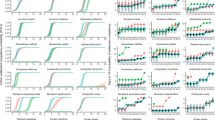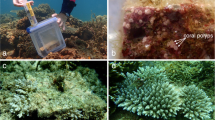Abstract
For close to a century, recruitment of larvae to a local population has been widely accepted as a primary determinant of marine population dynamics1,2. However, progress in elucidating the causes of recruitment variability has been greatly impeded by our ignorance of the sources of recruits. Although it is often assumed that recruitment is independent of local reproduction3,4,5,6, there is increasing circumstantial evidence that physical7,8 and behavioural9,10 mechanisms could facilitate larval retention near source populations. To develop a direct method for reconstructing the dispersal history of recruiting larvae, we put forward the hypothesis that differences in nutrient and trace-element concentrations between coastal and open oceans could result in quantifiable differences in growth rate and elemental composition between larvae developing in coastal waters (locally retained) and larvae developing in open ocean waters (produced in distant locations). Using this method, we show that recruitment to an island population of a widely distributed coral-reef fish may often result from local retention on leeward reefs. This result has implications for fisheries management and marine reserve design, because rates of dispersal between marine populations—and thus recruitment to exploited populations—could be much lower than currently assumed.
This is a preview of subscription content, access via your institution
Access options
Subscribe to this journal
Receive 51 print issues and online access
$199.00 per year
only $3.90 per issue
Buy this article
- Purchase on Springer Link
- Instant access to full article PDF
Prices may be subject to local taxes which are calculated during checkout


Similar content being viewed by others
References
Hjort,J. Fluctuations in the great fisheries of northern Europe viewed in the light of biological research. Rapp. P.-V. Réun. Cons. Perm. Int. Explor. Mer 20, 1–228 (1914).
Doherty,P. J. & Williams,D. McB. The replenishment of coral reef fish populations. Oceanogr. Mar. Biol. Annu. Rev. 26, 487–551 (1988).
Sale,P. F. in The Ecology of Fishes on Coral Reefs (ed. Sale, P. F.) 564–598 (Academic, San Diego, 1991).
Caley,M. J. et al. Recruitment and the local dynamics of open marine populations. Annu. Rev. Ecol. Syst. 27, 477–500 (1996).
Roughgarden,J., Iwasa,Y. & Baxter,C. Demographic theory for an open marine population with space-limited recruitment. Ecology 66, 54–67 (1985).
Warner,R. R. & Hughes,T. P. in Proc. 6th Int. Coral Reef Symp. (eds Choat, J. H. et al.) Vol. 1 149–155 (Coral Reef Symposium Executive Committee, Townsville, 1988).
Sammarco,P. W. & Andrews,J. C. Localized dispersal and recruitment in Great Barrier Reef corals: the helix experiment. Science 239, 1422–1424 (1988).
Wolanski,E. & Hamner,W. Topographically-controlled fronts in the ocean, and their influence on the distribution of organisms. Science 241, 177–181 (1988).
Neilson,J. D. & Perry,R. I. Diel vertical migrations of marine fishes: an obligate or facultative process? Adv. Mar. Biol. 26, 115–168 (1990).
Stobutzki,I. C. & Bellwood,D. R. Sustained swimming abilities of the late pelagic stages of coral reef fishes. Mar. Ecol. Prog. Ser. 149, 35–41 (1997).
Denman,K. L. & Powell,T. M. Effects of physical processes on planktonic ecosystems in the coastal ocean. Oceanogr. Mar. Biol. Annu. Rev. 22, 125–168 (1984).
Heywood,J., Barton,E. D. & Simpson,J. H. The effects of flow disturbance by an oceanic island. J. Mar. Res. 48, 55–73 (1990).
Rissik,D., Suthers,I. M. & Taggart,C. T. Enhanced zooplankton abundance in the lee of an isolated reef in the south Coral Sea: the role of flow disturbance. J. Plankton Res. 19, 1347–1368 (1997).
Bruland,K. W. in Chemical Oceanography Vol. 8 (eds Riley, J. P. & Chester, R.) 157–220 (Academic, San Diego, 1983).
Campana,S. E. & Neilson,J. D. Microstructure of fish otoliths. Can. J. Fish. Aquat. Sci. 42, 1014–1032 (1985).
Mugiya,Y., Hakomori,T. & Hatsutori,K. Trace metal incorporation into otoliths and scales in the goldfish, Carassius auratus. Comp. Biochem. Physiol. C 99, 327–331 (1991).
Campana,S. E., Gagné,J. A. & McLaren,J. W. Elemental fingerprinting of fish otoliths using ID-ICPMS. Mar. Ecol. Prog. Ser. 122, 115–120 (1995).
Gillanders,B. M. & Kingsford,M. J. Elements in otoliths may elucidate the contribution of estuarine recruitment to sustaining coastal reef populations of a temperate reef fish. Mar. Ecol. Prog. Ser. 141, 13–20 (1996).
Thorrold,S. R., Jones,C. M. & Campana,S. E. Response of otolith microchemistry to environmental variations experienced by larval and juvenile Atlantic croaker (Micropogonias undulatus). Limnol. Oceanogr. 42, 102–111 (1997).
Caselle,J. E. & Warner,R. R. Variability in recruitment of coral reef fishes: the importance of habitat at two spatial scales. Ecology 77, 2488–2504 (1996).
Gordon,A. L. Circulation of the Caribbean Sea. J. Geophys. Res. 72, 6207–6223 (1967).
Corredor,J. E., Morell,J. & Mendez,A. Dissolved nitrogen, phytoplankton biomass and island mass effects in the northeastern Caribbean Sea. Carib. J. Sci. 20, 129–132 (1984).
Boehlert,G. W., Watson,W. & Sun,L. C. Horizontal and vertical distributions of larval fishes around an isolated oceanic island in the tropical Pacific. Deep-Sea Res. 39, 439–466 (1992).
Cowen,R. K. & Castro,L. R. Relation of coral reef fish larval distributions to island scale circulation around Barbados, West Indies. Bull. Mar. Sci. 54, 228–244 (1994).
Shen,G. T. & Boyle,E. A. Determination of lead, cadmium, and other trace metals in annually-banded corals. Chem. Geol. 67, 47–62 (1988).
Lea,D. W., Shen,G. T. & Boyle,E. A. Coralline barium records temporal variability in equatorial Pacific upwelling. Nature 340, 373–376 (1989).
U.S. Environmental Protection Agency U.S. Virgin Islands Ambient Monitoring Survey Sept. 15–23, 1992 (Environ. Services Div. Region 2, Edison, NJ, 1995).
Hoff,G. R. & Fuiman,L. A. Morphometry and composition of red drum otoliths: changes associated with temperature, somatic growth rate, and age. Comp. Biochem. Physiol. A 106, 209–219 (1993).
Morse,J. W. & Bender,M. L. Partition coefficients in calcite: examination of factors influencing the validity of experimental results and their application to natural systems. Chem. Geol. 82, 265–277 (1990).
Overall,J. E. & Klett,C. J. Applied Multivariate Analysis (McGraw-Hill, New York, 1972).
Acknowledgements
We thank M. Sheehy for assistance with sample collection, L. Linn, P. Martin and T. Mashiotta for assistance with ICP-MS analyses, and N. Barbee, S. Cooper, S. Gaines, K. Lafferty and J. Shima for comments on the manuscript. This work was supported by the US NOAA-National Undersea Research Program, the US National Science Foundation, and the David and Lucille Packard Foundation.
Author information
Authors and Affiliations
Corresponding author
Rights and permissions
About this article
Cite this article
Swearer, S., Caselle, J., Lea, D. et al. Larval retention and recruitment in an island population of a coral-reef fish. Nature 402, 799–802 (1999). https://doi.org/10.1038/45533
Received:
Accepted:
Issue Date:
DOI: https://doi.org/10.1038/45533
This article is cited by
-
Variations in food resource usage among eight fish species inhabiting inside and outside Jinju Bay, Korea
Environmental Biology of Fishes (2022)
-
Genetic recruitment patterns are patchy and spatiotemporally unpredictable in a deep-water snapper (Lutjanus vivanus) sampled in fished and protected areas of western Puerto Rico
Conservation Genetics (2022)
-
Juvenile fish assemblages in the Jinju Bay region, Korea
Fisheries and Aquatic Sciences (2020)
-
Immunological characterization of two types of ionocytes in the inner ear epithelium of Pacific Chub Mackerel (Scomber japonicus)
Journal of Comparative Physiology B (2020)
-
Influence of hydrodynamic connectivity on the genetic structure and gene flow of the common pandora Pagellus erythrinus
Hydrobiologia (2019)
Comments
By submitting a comment you agree to abide by our Terms and Community Guidelines. If you find something abusive or that does not comply with our terms or guidelines please flag it as inappropriate.



